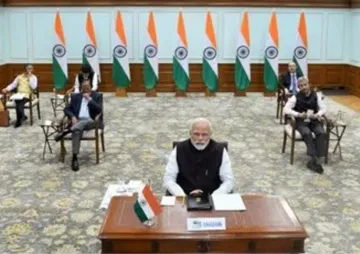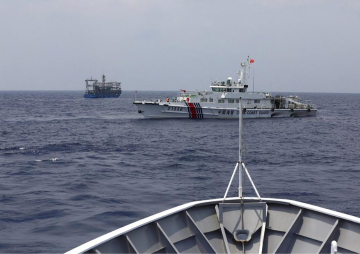As the Indo-Pacific region becomes an arena of strategic contestations, India and Australia’s interests are converging. Two large maritime states from two different continents, India and Australia were mutually indifferent for a long time. Today, however, their relationship is on the upbeat: not only is their bilateral trade on the rise, but they also have common concerns to balance an assertive China and uphold order in the region. By year-end, India and Australia are expected to conclude negotiations for a Mutual Logistics Support Agreement (MLSA). This brief locates the MLSA in the growing bilateral relationship, analyses the points of convergence between the two countries, and examines the most crucial obstacles in the way.
Introduction
India and Australia share a common concern in the maintenance of stability in what is increasingly becoming a highly contested Indo-Pacific environment. The Australian Defence White Paper (ADWP), 2016 rightly recognises that “the region’s seas and airspace are becoming more contested…as it does, several factors suggest we [would] face an increasingly complex and contested Indo–Pacific.”[1] In the same vein, Indian Prime Minister (PM) Narendra Modi had expressed his concerns about the security and stability of the region while addressing the Australian Parliament in 2014. “This vast region has many unsettled questions and new challenges. Historical differences persist despite growing inter-dependence…we worry about its access and security in our part of the world more than ever before.”[2]
The congruence of India and Australia’s views regarding the geopolitical situation in the Indo-Pacific makes the two countries, natural partners in establishing stability and peace in the region. After all, they are both beneficiaries of the free and open Indo-Pacific region that respects a rules-based order in consonance with international law. In recent years, the two have become more concerned about the stability of the region’s maritime order on account of the hostile attitude of some countries with stakes in the Indo-Pacific. For instance, ADWP 2016 mentions “the rule-based order” as one of Australia’s core strategic interests at least 56 times.[3] Australia’s Foreign Policy White Paper (AFWP) of 2017 also discusses the principles of the rule of law, openness, peaceful resolution of disputes in accordance with International Law, and, the right of freedom of navigation and overflight.
Illustrating India’s kindred principles, PM Modi has clearly enunciated his vision of the Indo-Pacific that “stands for a free, open, inclusive region” following “a common rules-based order”, respecting “sovereignty and territorial integrity” of a country “irrespective of (its) size and strength” and adhering to “freedom of navigation, unimpeded commerce and peaceful settlement of disputes in accordance with international law.”[4]
Where India meets Australia in the Indo-Pacific
Close security ties with the US
Australia and the US have been formal treaty alliance partners since the end of the Second World War, and this alliance continues to stand firm despite initial doubts resulting from some statements made by US President Donald Trump.[5] The AFWP, 2017 asserts that “(the) alliance with the United States is central to Australia’s security and sits at the core of our strategic and defence planning… Australia will continue to ensure the strength and vitality of our alliance.”[6] Such close relations help Australia to source high-end military hardware from the US and allow it to better respond to emerging security challenges.
India, too, has established close security ties with the US in the last decade, becoming an important component of the US-stitched networked architecture that is built on shared values and interests. Thus, in this partnership, while the US has a reliable partner shouldering its responsibility in the Indo-Pacific, India also counts on an essential partner on the world stage and access to cutting-edge military hardware. There is a parallel between increased bonhomie between India and US on the one hand, and that of India and Australia on the other. The US, therefore, is a crucial pivot point in the India-Australia relationship and it has helped the bilateral relationship to grow stronger.
Hedging vis-à-vis the US and China
Both India and Australia are walking a tightrope in their ties with the US and China. Australia was the first country to exit from the Quadrilateral 1.0[a] back in 2007, fearing the reaction of China. India followed suit to soothe China’s nerves. Although the scenario has seen a sea-change in the past decade, neither India nor Australia wants to openly alienate China, which happens to be their largest trading partner. Australia has clearly stated that it “will strengthen relations with China…and is committed to advancing (the) Comprehensive Strategic Partnership with China.”[7]
India, after the Wuhan Summit in 2018, is avoiding any steps that may be perceived as overtly anti-China. Moreover, India has met with some obstacles in its economic relations with the US and is on the same ground as China vis-à-vis unilateral actions being taken by the US on trade issues. Due to the unpredictable behaviour of the incumbent US administration, both Australia and India are keeping their options open by seeking to engage both China and the US.
Challenges in the neighbourhood
China has been increasingly challenging the traditional areas of influence of both India and Australia, i.e., the Indian subcontinent and South Pacific Islands, respectively. With its so-called String of Pearls, China has penetrated India’s peripheral littoral states using the promise of economic largesse. Although India has reversed some of these trends in Sri Lanka and the Maldives in the recent past, the situation remains precarious as the strategic gains can be easily undone with a change of regime in those countries. Moreover, China’s growing deployments in the Indian Ocean has thrown a challenge to India[8] in its immediate neighbourhood. The Modi government has made the Indian Ocean region its priority in its second term and Prime Minister Modi has led the way in reaching out to India’s neighbours.
On the Australian continent, China is trying to win over the Pacific countries through chequebook diplomacy. In recent years, small islands such as Vanuatu, Tonga and the Solomon Islands have become beneficiaries of China’s seemingly generous economic outreach.[9] Moreover, China is revealing its designs for the region with its plans to establish a base on the tiny island of Vanuatu.[10] Such reports have caused concern in the Australian establishment, as the country is “geographically wedded to the region”.[11] After his re-election in 2019, PM Scott Morrison made his first overseas visit to the Solomon Islands which was seen as an attempt to rein in China’s influence in that country as well as over the entire region.[12]
Neither Australia nor India feels threatened by each other investing economically or politically in their neighbourhoods. Modi travelled to Fiji in 2014, becoming the first Indian PM to visit a South Pacific country in 33 years; there he laid the foundation for the Forum for India-Pacific Islands Co-operation (FIPIC). India pledged US $ 1 million towards climate change assistance to Fiji’s COP23 Presidency during the 2017 India-Pacific Islands Sustainable Development Conference. It also signed a few Memorandums of Agreement (MoUs) with Fiji, extending a Line of Credit for Establishing a Co-Generation Plant and Cooperation in the field of training of diplomats, among others. Amidst all these engagements, Australia has not expressed disapproval about India’s presence in the Pacific region. Likewise, Australia’s four-year, A$ 25-million programme to support regional connectivity in South Asia under the name South Asia Regional Infrastructure Connectivity Initiative (SARIC) has been well-received in India. As China challenges Canberra and New Delhi in their traditional geographies, the two nations have found in each other reliable partners.
Cooperation in multilateral forums
India and Australia are part of nearly half a dozen regional multilateral forums including the ASEAN Regional Forum (ARF), ASEAN Defence Ministers’ Meeting Plus (ADMM+), East Asia Summit (EAS), Indian Ocean Rim Association (IORA), and the Indian Ocean Naval Symposium (IONS). Both India and Australia put the principle of ‘ASEAN centrality’[b] at the heart of their policymaking and similarly have a stake in ASEAN unity. While India has welcomed ASEAN’s Indo-Pacific Outlook, Australia shares a common view with the principles enunciated in the outlook. In the Indian Ocean Region, the two are giving support to the IORA’s Jakarta Concord, 2017[13] that “lays out the vision of IORA for the future, focussing in particular on cooperation among the 21 IORA member states on maritime safety and security.”[14]
In the security domain, India has participated in the Exercise Kakadu 18, a regional multilateral maritime engagement exercise hosted by the Royal Australian Navy (RAN) and supported by the Royal Australian Air Force (RAAF) in the port of Darwin.[15] Further, an Indian delegation was invited as observers to the Exercise Talisman Sabre 2019, a bilateral Australian and US training activity, along with a few other Indo-Pacific countries.[16] Both India and Australia are also part of other multilateral naval exercises such as Rim of the Pacific (RIMPAC) hosted by the US and the Exercise MILAN hosted by India.
Irritants in the relationship
India-Australia relations face various barriers; some of these are owed to history while others are the results of more contemporary events. Although the bilateral relationship has strengthened over the past decade, it is yet to come of age as a mature relationship independent of major powers such as the US and China. The following are some of the most crucial obstacles in the relationship.
Australia’s non-inclusion in the annual Malabar exercises
India denied Australia’s bid to take part in the 2018 iteration of the India-US-Japan Malabar naval exercise. This decision can be attributed to two reasons. First, India feared that Australia would repeat what it had done in 2007, i.e., to quit the Quadrilateral at the initial stage. Although the then Australian Prime Minister Kevin Rudd gave an account of the reasons behind his decision in 2007, Australia was the first country to quit the Quadrilateral 1.0.[17] Thus it could be said that India’s suspicions were founded. Second, India did not want to provoke China in the aftermath of the Doklam stand-off and the subsequent informal summit between PM Modi and President Xi Jinping in Wuhan. Including Australia at that point would have unnecessarily indicated that they were colluding against China.
India’s slow approach to trade negotiations
India has been going slow on negotiating with Australia the free trade agreement, Comprehensive Economic Cooperation Agreement (CECA); India is also not highly keen on the Regional Comprehensive Economic Partnership (RCEP)[c] negotiations. The report, ‘An Indian Economic Strategy to 2035’, commissioned by the Australian Government in 2018, states that India and Australia “are too far apart” to conclude CECA in the near future and instead must focus on concluding the RCEP before returning to bilateral trade negotiations.[18] However, India is reluctant to negotiate a deal on RCEP, fearing the negative impact of cheap Chinese imports on the country’s indigenous industries.
Table 1: India’s imports from, and exports to Australia (2009-2018, in US$ billion)
| Year |
Imports |
Exports |
| 2018-2019 |
13.131 |
3.520 |
| 2017-2018 |
13.993 |
4.012 |
| 2016-2017 |
11.154 |
2.957 |
| 2015-2016 |
08.898 |
3.262 |
| 2014-2015 |
10.247 |
2.782 |
| 2013-2014 |
09.822 |
2.300 |
| 2012-2013 |
13.085 |
2.348 |
| 2011-2012 |
15.578 |
2.476 |
| 2010-2011 |
10.789 |
1.713 |
| 2009-2010 |
12.407 |
1.384 |
Source: Department of Commerce, Export Import Data bank, Government of India
Considering New Delhi’s intransigence on the RCEP, China is exerting pressure on India to yield to majority demands. China has started pushing for an ASEAN+3 free trade pact, leaving out India, Australia and New Zealand.[19] Thus, Australia, which has “taken a leadership position in working with India’s concerns” is pushing India to complete negotiations so that RCEP can be rolled out at the earliest.[20] Like many East Asian states, Australia’s patience is wearing thin with New Delhi’s stand on trade negotiations.
Historical mistrust
During the Cold War, India and Australia stood on opposite ideological poles. Lack of trade relations and preoccupation with their respective neighbourhoods prevented the two from exploring the potential of their own relationship. As the Cold War thawed, India and Australia began engaging with each other even as many in India perceived Australia as a US “stooge”.[21] Australia’s vacillation over uranium sales to India in 2007 added to the already existing mistrust between two countries.[22] Australia came on board in 2011 after India signed a nuclear deal with the US, underscoring for many in New Delhi the non-independent nature of its foreign policy decision-making. But since then, bilateral relations between the two nations have seen an exponential growth.
The relevance of MLSA
Aside from being together in several multilaterals, India and Australia are also in three minilaterals, viz. the India-Japan-Australia trilateral, India-Indonesia-Australia trilateral and India-Japan-US-Australia Quadrilateral. For all three, discussions take place at the level of senior government officials. Although these minilaterals have little to showcase in terms of achievements, they have strengthened relations among the participants, as seen for instance in the case of India and Australia.
The relationship between the two countries suffered from relative apathy until the NDA government took the reins in 2014 under the stewardship of PM Modi. To be sure, the two countries did come together for disaster relief operations following the Indian Ocean Tsunami of 2004 and were part of the Quadrilateral 1.0. They could not, however, overcome their historical baggage. In 2009, the relationship was elevated to a ‘Strategic Partnership’, and the subsequent ADWPs identified India as being a likely contender to have “a stronger voice and stake in strategic affairs.”[23] The two started a new chapter in their relationship only in 2014 following the power shift in New Delhi.
Australian PM Tony Abbott became the first leader to visit PM Modi after his victory, aside from the leaders of the South Asian Association for Regional Cooperation (SAARC). The two countries signed the Civil Nuclear Cooperation Agreement despite differences regarding nuclear non-proliferation and disarmament. The next encounter between the two leaders happened just after two months, in Brisbane, when Modi became the first Indian PM to visit Australia after 28 years. During the visit, the two sides signed a Framework for Security Cooperation which has guided the bilateral relations since. The plan included an annual summit, foreign ministers’ and defence ministers’ meetings; regular bilateral maritime exercises; and an annual bilateral dialogue on maritime security.[24] The momentum remained even after the change of leadership in Australia. The new PM Malcolm Turnbull visited India in 2017. Both countries decided to commence the 2+2 dialogue between their defence and foreign secretaries. Continuing the thrust, Indian President Ramnath Kovind visited Australia in November 2018.
The high-level visits were matched by action on the ground in terms of security dialogues and military exercises. Army-to-army contact was strengthened by the joint military exercise AUSTRA HIND, which has already completed two iterations.[25] In 2018, the Indian Air Force participated in Exercise Pitch Black, a biennial multi-national large force employment warfare exercise, hosted by the Royal Australian Air Force in Darwin, Australia for the first time in history.[26] In the maritime domain, the fourth iteration of the India-Australia Maritime Dialogue was held in Canberra in November 2018,[27] while the third iteration of their bilateral maritime exercise — AUSINDEX 2019 — was held in April 2019 in the Bay of Bengal.
Table 2. Major defence exercises between India and Australia
| Exercise |
Conducting/Hosting Entity |
India/Australia’s Participation |
| Exercise Kakadu |
A joint-enabled, biennial exercise hosted by the Royal Australian Navy and supported by the Royal Australian Air Force |
India, since 2016 |
| Exercise Talisman Sabre |
A bilateral combined training activity between Australian Defence Force and United States military |
India, Observer in 2019 |
| Rim of the Pacific (RIMPAC) |
A biennial international naval exercise hosted by the US Navy |
India, since 2012 |
| MILAN |
A biennial multilateral naval exercise hosted by the Indian Navy |
Australia, since 2003 |
| Exercise AUSTRA HIND |
A joint military exercise conducted between India and Australia |
Held in 2016-2017 and 2017-2018 |
|
Exercise
Pitch Black
|
A biennial multi-national
warfare exercise hosted by
the Royal Australian Air Force
|
India, in 2018 |
| AUSINDEX 2019 |
A biennial bilateral maritime exercise between India and Australia |
Held in 2015, 2017, 2019 |
Source: Compiled from various open sources.
AUSINDEX 2019 was the cornerstone of wider Indo-Pacific Endeavour deployment — Australia’s maritime diplomacy tool exhibiting both hard and soft aspects of diplomacy — in the Indo-Pacific. The exercise saw the largest deployment of Australian forces to India so far.[28] Considering the increased Chinese naval presence in the Indian Ocean Region, the exercise focused mainly on anti-submarine warfare. According to Commander Mitchell Livingstone, Commanding Officer, HMAS Toowoomba of the Royal Australian Navy, “It was one of the most complex exercises ever be carried out between the militaries of the two nations. It involved advanced warfare drills, including anti-submarine, air defence, and anti-surface warfare exercises, as well as cross deck flying. In addition, it was the first time the P-8 aircraft, the Australian maritime patrol, had flown on a coordinated mission with another country.”[29]
Building on their bilateral naval exercises, India and Australia are in the advanced stages of negotiating a Mutual Logistics Support Agreement (MLSA) and expect to conclude it by the end of the year. The MLSA assumes greater importance in light of India and Australia’s limited naval capabilities. Normally, a scarcity of resources puts severe limitations on a country’s ability to project power in the distant waters, leaving its far-off assets at the mercy of other actors. Therefore, countries avoid dispersion of their resources and concentrate on their near waters. In the case of India and Australia, such a limitation does not match their ambitions in the region; it also puts them at a disadvantage vis-à-vis a belligerent China. For this reason, the MLSA holds considerable significance.[30]
The MLSA is a bilateral agreement between the countries that allows reciprocal access to military facilities in terms of logistics support which generally include food, water, petroleum (fuel), spare parts and other components. The agreement will be useful during joint military exercises, peacekeeping operations, Humanitarian Assistance and Disaster Relief operations, scheduled deployments of military platforms, and any other exigent situations that may arise. It will help in improving interoperability between the involved parties.
Both India and Australia have island territories in the Indian Ocean at vantage locations. India’s Andaman and Nicobar Island chain straddles the Malacca Strait, one of the primary choke points across a key maritime highway. Likewise, Australia’s Coco Islands are located near Southeast Asia and have significant strategic value. According to Australian Foreign Minister Marise Payne, “Australia has a long Indian Ocean coastline along with one of the largest Exclusive Economic Zone and largest Search and Rescue zone in the world. Additionally, it has oil reserves on its north-west shell. Australia is heavily dependent upon the Indian Ocean for its trade and energy security.”[31]
Similarly, India has legitimate interests in the wider Indo-Pacific with its ever-increasing trade with the countries in the region. It faces occasional challenges in the distant waters of South China Sea, the latest being China’s deployment of a survey vessel escorted by coast guard ships, close to waters where state-owned ONGC Videsh is engaged in oil and gas production.[32] The conclusion of MLSA at the earliest will help improve the capabilities of both nations to operate in distant waters.
Moreover, the ongoing negotiations over MLSA are in consonance with India’s recent maritime foreign policy manoeuvres. In the recent past, the country has concluded several logistics agreements with various countries including France, Oman, the Philippines, Singapore and South Korea. India is negotiating more such agreements with Japan and Russia. Similarly, Australia has recently concluded a logistics sharing agreement with Japan in addition to the existing pacts with the US and New Zealand. Thus, a logistics support agreement between India and Australia will be integral to the community of law-abiding nations working to uphold the prevailing order in the Indo-Pacific.
Conclusion
India-Australia relations have come a long way since the time of mutual mistrust between the two, only relics of which remain today. Although it cannot be said that there are no impediments in the relationship, they are insignificant when compared to the points of convergence. The strategic relationship has been on the buildup for the past few years. The bilateral and multilateral military exercises alone illustrate that the two countries are working to increase interoperability to maintain favourable order in the region. The proposed MLSA will add enormously to the endeavour. Furthermore, the agreement can be conceived of as only one of several Logistic Support Agreements between the US and its partners in the Indo-Pacific that will help them multiply their limited capabilities to tackle any unforeseen events.
Endnotes
The views expressed above belong to the author(s). ORF research and analyses now available on Telegram! Click here to access our curated content — blogs, longforms and interviews.

 PDF Download
PDF Download



 PREV
PREV



